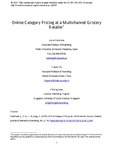Mostrar el registro sencillo del ítem
Online category pricing at a multichannel grocery retailer
| dc.creator | Cebollada Calvo, Javier | es_ES |
| dc.creator | Chu, Yanlai | es_ES |
| dc.creator | Jiang, Zhiying | es_ES |
| dc.date.accessioned | 2020-01-07T12:20:42Z | |
| dc.date.available | 2021-05-01T23:00:11Z | |
| dc.date.issued | 2019 | |
| dc.identifier.issn | 1094-9968 | |
| dc.identifier.uri | https://hdl.handle.net/2454/36001 | |
| dc.description.abstract | As the importance of online grocery shopping increases, both pure-play online grocers and multichannel grocers are likely to be interested in setting optimal prices for their online stores. We use a unique household scanner panel dataset to investigate how a grocery retailer with both online and offline stores can set prices for its online store. We observe the same households shopping interchangeably at the online and offline stores of the same grocery chain and investigate their purchase behavior in specific product categories. We find that across three product categories, these households exhibit lower price sensitivities when shopping online than offline. In addition, a household's price sensitivity is inversely related to distance to the closest physical store. We compute the retailer's category profit-maximizing prices for the online store and explore several alternative pricing schemes that are consistent with the retailer's current price image. We find that the retailer can substantially increase its profits from online operations by fine tuning its current pricing policy. Given the estimated inverse relationship between price sensitivity and store distance, we investigate online zone pricing as a price discrimination tool based on residential location and find that the retailer can further improve store profits. We examine the potential mechanism to assign zones and determine the optimal number of pricing zones. | en |
| dc.description.sponsorship | This project is partially supported by the Spanish Ministry of Science and Innovation Research Project ECO2015-65393-R and the National Natural Science Foundation of China Research Project 71802187. | en |
| dc.format.extent | 45 p. | |
| dc.format.mimetype | application/pdf | en |
| dc.language.iso | eng | en |
| dc.publisher | Elsevier | en |
| dc.relation.ispartof | Journal of Interactive Marketing, 46 (2019) 52-69 | en |
| dc.rights | © 2019 Direct Marketing Educational Foundation, Inc. dba Marketing EDGE. All rights reserved. This manuscript version is made available under the CC-BY-NC-ND 4.0. | en |
| dc.rights.uri | http://creativecommons.org/licenses/by-nc-nd/4.0/ | |
| dc.subject | Multichannel retailing | en |
| dc.subject | Zone pricing | en |
| dc.subject | Scanner panel data | en |
| dc.subject | E-commerce | en |
| dc.subject | Price discrimination | en |
| dc.title | Online category pricing at a multichannel grocery retailer | en |
| dc.type | info:eu-repo/semantics/article | en |
| dc.type | Artículo / Artikulua | es |
| dc.contributor.department | Gestión de Empresas | es_ES |
| dc.contributor.department | Enpresen Kudeaketa | eu |
| dc.rights.accessRights | info:eu-repo/semantics/openAccess | en |
| dc.rights.accessRights | Acceso abierto / Sarbide irekia | es |
| dc.embargo.terms | 2021-05-01 | |
| dc.identifier.doi | 10.1016/j.intmar.2018.12.004 | |
| dc.relation.projectID | info:eu-repo/grantAgreement/MINECO//ECO2015-65393-R/ES/ | en |
| dc.relation.publisherversion | https://doi.org/10.1016/j.intmar.2018.12.004 | |
| dc.type.version | info:eu-repo/semantics/acceptedVersion | en |
| dc.type.version | Versión aceptada / Onetsi den bertsioa | es |



